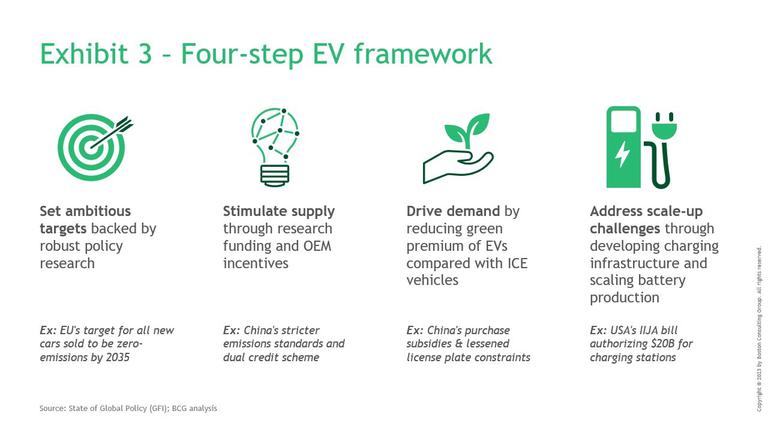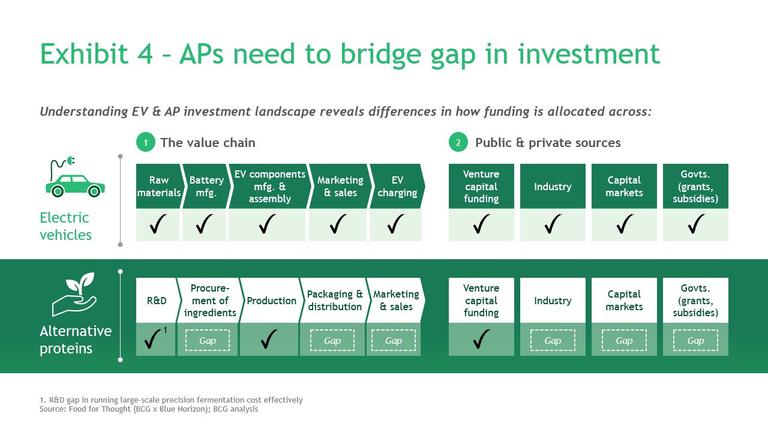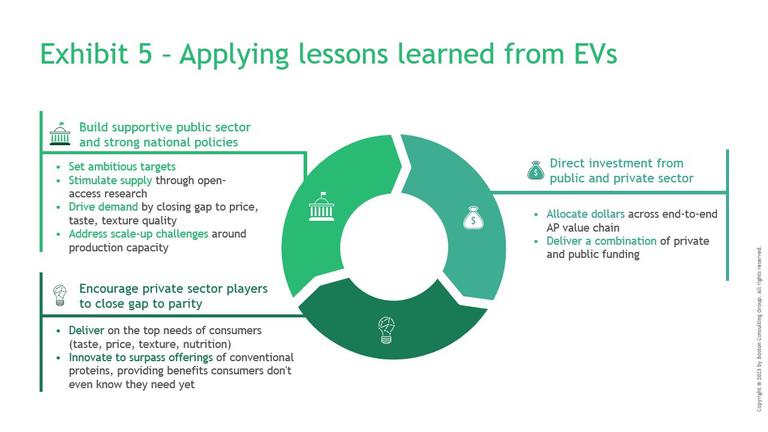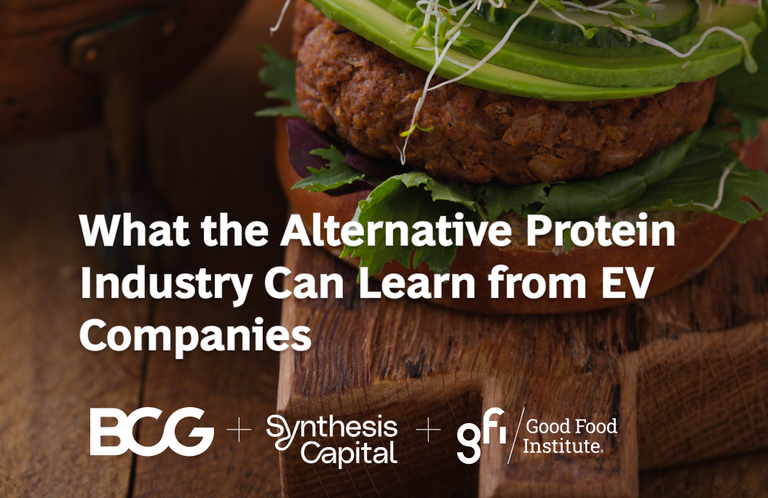New report: Sustainable Synergies - Lessons from the Adoption of Electric Vehicles
• Market Update • Technology • Feature
We recently released a new report titled What the Alternative Protein Industry Can Learn from EV Companies with Boston Consulting Group (BCG) and The Good Food Institute (GFI). The full article is linked here, with highlights summarized below.
Mass adoption of alternative proteins is critical in tackling climate change. Animal agriculture accounts for roughly 15% to 20% of greenhouse gas emissions—more than cars, motorcycles, and other passenger light vehicles. If alternative proteins could capture half of the global protein market, including dairy, this switch would mitigate 5 gigatons of CO2 equivalents annually. For the alternative protein industry to scale, it should take inspiration from the electric vehicle industry, in which companies offered a better product for the consumer, governments provided generous support, and investors funded across the value chain.
Lesson 1: Alternative protein companies need to innovate to achieve parity with animal proteins
Just as electric vehicles (EVs) did not see adoption until the quality became comparable to gas-powered vehicles, alternative protein products won’t take off until they match animal proteins in taste, texture, and price. EV makers used investments they received to innovate on vehicle quality and cost, closing the gap with combustion vehicles on price, range, and usability. They delivered great cars with innovative features not found in traditional vehicles, like improved safety features and superior acceleration. With this, sustainability became a bonus, not a sacrifice. The most successful alternative protein producers will be those who first deliver on taste and price and then innovate with added benefits, such as enhanced nutrition. Sustainability alone will not drive adoption, excellent products will.
Lesson 2: Strong national policies and a supportive public sector are essential
Public-sector support accelerated EV adoption through a four-step framework in which governments:
- Set ambitious targets around alternative protein adoption and sales. For example, the EU's target for all new cars sold to be zero-emissions by 2035.
- Stimulate supply by supporting open-access scientific research into alternative proteins and product commercialization. For example, China’s strict emissions standards and dual credit scheme.
- Drive demand by enacting regulations to help companies bring innovative proteins to market. For example, China’s purchase credits and streamlined license plate registration.
- Address scale-up challenges and labour concerns by providing funding for workforce training and the construction of production capacity. For example, USA’s IIJA bill authorizing $20b for charging stations.

Governments should mirror this support in alternative protein by setting ambitious targets for food system carbon reduction, funding early-stage R&D, streamlining approval processes, and investing in scale-up infrastructure. The Singapore government has set an example for alternative protein support by setting targets to produce 30% of its nutritional needs domestically, dedicating $107m for alt-protein R&D, pioneering a cultivated meat regulatory framework, and building shared laboratory and production spaces in their Food Tech Innovation Centre.
Lesson 3: More public and private investment is needed across the value chain
Public and private investment across the value chain accelerated electric vehicle adoption. There are major gaps in funding for alternative protein. The alternative protein ecosystem should not only invest in R&D, but also in ingredient procurement, production capacity, packaging, distribution, and marketing. Additional private and public investment is needed, such as government-backed research institutions or public-private infrastructure partnerships.

Looking forward
Stakeholders should embrace and accelerate alternative protein by providing targeted support.
- Governments: Craft supportive public policy leveraging the four-step framework.
- Investors: Channel investment dollars across the value chain. Encourage companies to narrow the gap with conventional proteins.
- Incumbent food companies: Innovate early and set alternative protein industry standards.
- Alternative protein companies: Launch competitively priced products with excellent taste, texture, and nutrition.

Scaling up to offer products that are competitive with conventional proteins on taste, price, and convenience is a sizable challenge. But with continued investment, innovation, and collaboration across the alternative protein ecosystem, companies can lay the foundation for a more sustainable and secure food system.
This report was a collaboration between BCG, GFI, and Synthesis Capital. Read more here.




